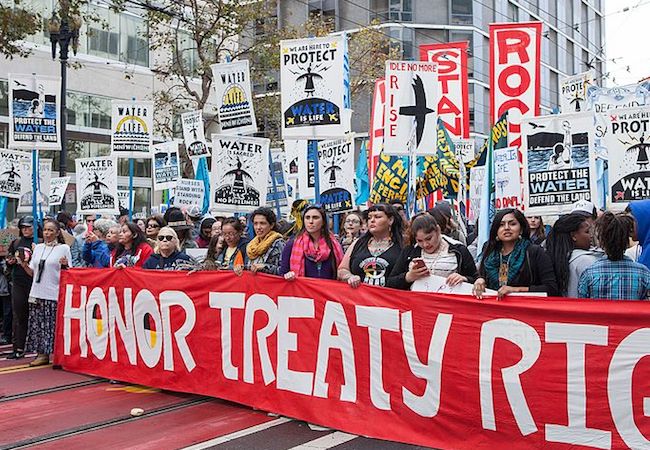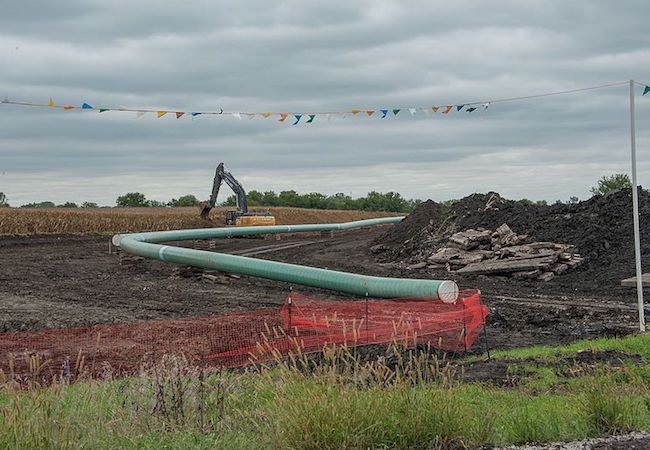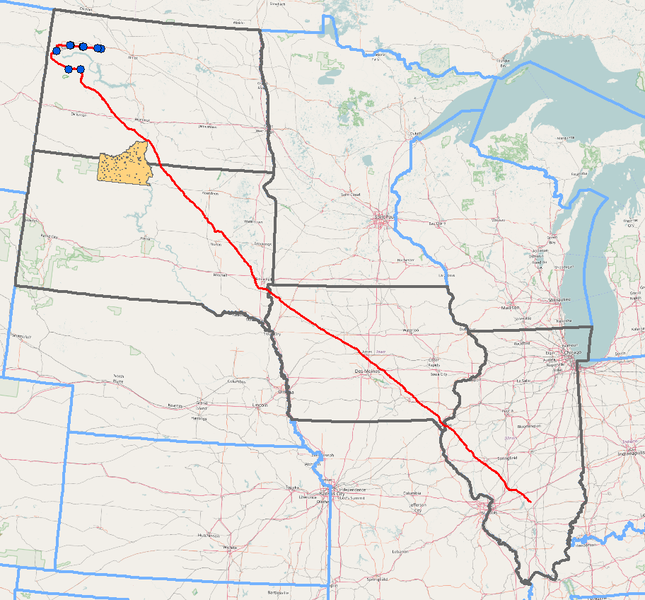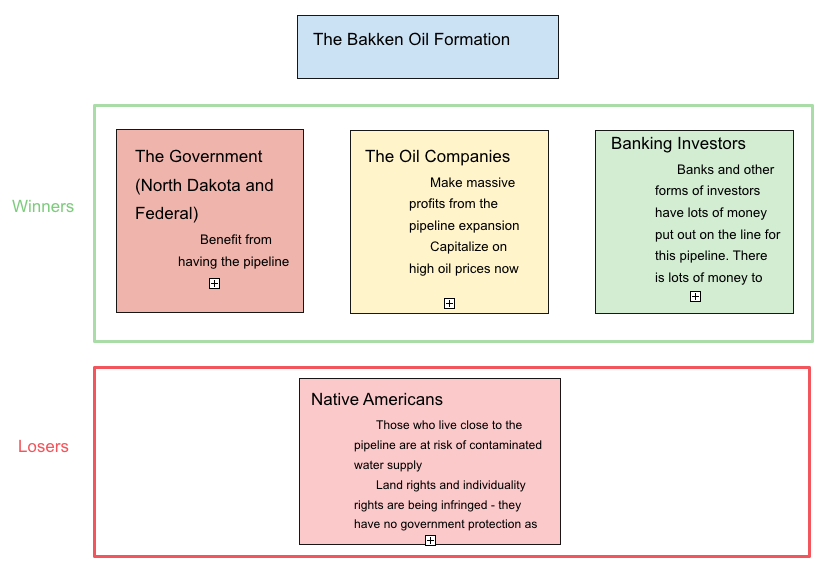
By David McDonald
The controversy surrounding the Dakota Access Pipeline has been on the news for quite some time now, and everytime I witness innocent protesters being tear gassed by police, I grow more and more outraged at the idea of the whole situation.
I find the story of the dakota access pipeline one that is of great importance in this day in age. It outlines so many things that are wrong with America, and it also shows how citizens will unite against large corporate powers that only care about profits.
I think it’s amazing to see all of these people to come together to protest the controversial pipeline. However, after months of protesting, it seems not much has changed. I’m still seeing violence on the news surrounding this problem, even months after protests began.
So what is really going in in North and South Dakota?
A brief history of oil in the Dakotas
As you already know, oil is very lucrative. Oil creates jobs, oil aids trade surpluses by increasing exports, and oil helps circulate billions of dollars throughout the global financial market every year. Needless to say, whenever new formations of oil are discovered, they will be drilled, and there will be A LOT of money being made throughout the process.
This is exactly what happened in North Dakota back in 2006, when a company by the name of EOG Resources discovered the Parshall Oil Field from the Bakken Formation located across North-Western Dakota.
Inevitably, the discovery of this massive oil formation led to what has been called the North Dakota Oil Boom. This extraction of oil peaked in 2012, and has declined since then due to a global decline in oil prices. Despite the Great Recession, the oil boom provided North Dakota with enough jobs to shrink their unemployment rate to the lowest of any other state in the country. This creation of jobs supplied the state with an effective $ one billion budget surplus. The economy was good — residents were happy.
Realizing the huge economic potential of this newly discovered oil formation, oil companies acted fast to reap the financial benefits awaiting them at this massive oil field. From an economic point of view, this makes sense; when a new natural resource presents itself, there is a large (new) supply for companies to drill, and because the new resource is gasoline, there will always be a consumer demand.
With that being said, many companies raced over to North Dakota, some of the largest being:
- Apache
- Arsenal Energy Inc.
- ConocoPhillips
- Continental Resources
- Earthstone Energy
- Emerald Oil
- Enerplus
- EOG Resources
- ExxonMobil
- Forestar Group
- Halcon Resources
- Hess
- Kodiak Oil & Gas Corp
I listed these companies to give you a sense of scale of how large the oil-drilling operation is in North Dakota. Above is a short snapshot of the investments in the state, believe me, there are many more. Each of these companies have large rigs setup with the goal of drilling as much oil as humanly possible — this operation is big.
So big, that The North Dakota Government released a statement predicting there to be an estimated 24 billion barrels of oil that could potentially be extracted from the Bakken Formation. This is a lot of oil, but how long would this take to become depleted? Well, a 2010 estimate claims oil production rates had reached 458,000 barrels per day. At this rate, it would take 52,401 days to extract all of the oil located in the Bakken Formation (or, 143 years).
Clearly, this wasn’t fast enough. Oil companies fully realize that the price of oil will be much lower 143 years from now because renewable energy will be the way of the future. Thus, they want to pump as much oil as possible, as soon as possible.
More than one million barrels a day, that cuts down the time to deplete the Bakken formation from 143 years to approximately 65 years. Yep, still too long, given that renewable energy’s are bound to take over the market by the midpoint or turn of the century.
So let’s look at it from an oil company’s perspective. Do they really want to spend the next 65 years drilling oil from this goldmine? Of course not. So, being the savvy businessmen that they are, they conjure up this cool thing called the Dakota Access Pipeline!

The Dakota Access Pipeline: What Is It?
The economy in North Dakota is booming. Unemployment is lower there than anywhere else in America, and they still enjoy budget surpluses that help fund public facilities — all thanks to the discovery of a massive oil formation.
Ideally, one would think that the North Dakotan government would want to prolong the lifespan of this oil field, however, when the Dakota Access pipeline was announced, North Dakota Gov. Jack Dalrymple had just urged industry and government officials to build more pipelines to keep pace with the state’s oil production, which is second only to oil production in Texas.
By deciding to allow the construction of more pipelines, the governor of North Dakota, Jack Dalrymple, is not acting in favor of the citizens of North Dakota. The oil will be drilled in way less than 65 years, and the low unemployment rate due to the oil boom? Gone, because the government didn’t act to prolong any careers in the industry.
So, with demand for North Dakota oil skyrocketing, and with a government keen on exporting as much oil as possible, as fast as possible, we are left with the foundation for a massive pipeline, that will add 1200 more miles to an already gargantuan pipeline that stretches 71,000 miles.
If completed, the pipeline will connect the Bakken formation to Patoka, Illinois. It serves as a faster, more efficient means of transportation of oil, which effectively eliminates the need for rail and truck transportation of the oil (which can and will cause devastating accidents.) The pipeline aims to transport approximately 470,000 barrels per day with a capacity as high as 570,000 barrels per day, which adds at least 50% more exporting ability onto current Bakken crude oil production.
The pipeline is scheduled to be finished by the end of 2016.
Here’s where things get interesting…
I’m assuming everyone reading this is aware of the Dakota Access Pipeline issue already. But I’m going to take a step back and speak briefly, as if you were unaware of the events that are currently taking place.
Assuming this, and assuming all of the information I have just presented, I can’t blame you for asking what the big deal is about this pipeline. From the surface (aside from the social implications this pipeline brings) this project simply seems like another oil pipeline. There are thousands of them across the globe, so why is this one so important?
It has to do with the fact that this pipeline will be crossing sacred native land. Even more concerning, is the fact that the pipeline will also “cross 209 rivers, creeks and tributaries” along the way. Most pressing to the tribe however is the fact that it could potentially destroy ancient burial grounds and other sacred sites as well as threaten the Missouri River which currently acts as the tribe’s main source for irrigation and drinking water.
An in-depth 2010 report from Worcester Polytechnic Institute, which looked at the effects of three major oil spills, found increased incidences of cancer and digestive problems in people who had ingested the oil directly (in drinking water) or indirectly (through eating the meat of livestock exposed to the oil).
In addition, people who had used contaminated water for bathing or laundry appeared to experience a higher incidence of skin problems, ranging from mild rashes to severe and lasting eczema and malignant skin cancers.
It seems almost arbitrary to say, but consuming water that has been contaminated with oil is extremely dangerous to the health of the inhabitants consuming that water.
This raises the argument for the pipeline that the pipeline itself is safe, and is assured not to leak any oil. However, history, and statistics proves otherwise.
According to a study done by rowan cockett, an oil pipeline on average, sees a return on investment after a pipeline leakage within a 4-5 year period, making it a popular investment for oil companies when the next alternative is a 61 year return on investment period for a marine terminal spill, and upwards to a 250 year period on a full-blown oil pipeline rupture. The chance of an oil pipeline leakage? 25% according to this study.
25% is a large claim, but history backs it up.
Since 2010, over 3,300 incidents of crude oil and liquified natural gas leaks or ruptures have occurred on U.S. pipelines. These incidents have killed 80 people, injured 389 more, and cost $2.8 billion in damages. They also released toxic, polluting chemicals in local soil, waterways, and air.
These results are staggering, but it is the harsh reality that comes with drilling this much oil. After seeing these diagrams, it essentially disproves my proposed ‘potential’ argument that oil pipelines are a safe, efficient means of transporting crude oil.
If the Dakota Access Pipeline is fully functional, statistics say there is a 25% chance every year that a leakage occurs somewhere along the pipeline. Although the U.S. Army Corps of Engineers conducted a limited review of the route, involving an environmental assessment of river crossings and portions of the project related to specific permits, and issued a finding of no significant impact, this does not mean that there will not be any significant environmental impact. I mean, just look at the graph above.
Thus, whether this leakage spills into a native water-way can’t be predicted, but it is a gamble that natives living in North and South Dakota do not want to take.

If the Dakota Access Pipeline becomes fully operational, it jeopardizes the way of life for thousands of native Americans living in regions that surround the pipeline.
America was built off of large scale colonization and imperialism. It was founded by wealthy Spanish and British explorers, to which they murdered literally millions of native Americans in order to capture a land that did not belong to them.
Needless to say, the land that is being drilled into by oil companies is stolen land. It is land that has been captured by the native Americans through intimidation and brute force.
Protests by native Americans began in April of 2016 in an attempt to dispute the construction of this controversial pipeline.
Activists that include several native American tribes, most notably the Standing Rock Sioux, in March and April 2016, asked the Army Corps of Engineers to conduct a formal Environmental Impact Assessment and issue this statement before commencing the construction of the pipeline.
In July, however, the Army Corps of Engineers approved the water crossing permits for the Dakota Access Pipeline under a “fast track” option, and construction of the disputed section of pipeline continued, saying “the Corps effectively wrote off the tribe’s concerns and ignored the pipeline’s impacts to sacred sites and culturally important landscapes,” the Standing Rock Sioux Tribe filed suit against the Corps of Engineers, accusing the agency of violating the National Historic Preservation Act and other laws, to which they lost.
Whether or not the Army Corps of Engineers actually ignored the pipeline’s impacts to sacred sites is unknown, but that doesn’t deny the fact that Native American’s are being treated as second-class citizens in this whole ordeal. Their land, their health, and their overall way of life is being jeopardized with this potential pipeline, and nobody with substantial influence in the outcome of this ordeal seems to particularly care about them — probably because the natives don’t have millions of dollars to offer anyone like the oil companies do.
In April, a Standing Rock Sioux elder established a camp as a center for cultural preservation and spiritual resistance to the pipeline. Over the summer the camp grew to thousands of people.
Since then, numbers have grown by the thousands, including notable celebrities and other icons; yet, construction still continues.
What’s even more saddening about this is that these protests are not gaining much mainstream media coverage at all, until recently — and things are only getting worse.
In September, construction workers bulldozed a section of land that tribal historic preservation officers had just documented as a historic, sacred site, and when protesters entered the area security workers used attack dogs, which bit at least five of the protesters.
Since then, protests have gotten more violent, and the backlash from authorities more harsh. During the course of the protests over 120 people have been arrested, there have been incidents with guns and injuries, as well as repeated use of tear gas by authorities to help contain protesters.
A report states: A standoff between Dakota Access Pipeline protesters and law enforcement degenerated into violence Thursday when two protesters opened fire in separate incidents, wounding a “private individual” and narrowly missing a sheriff’s deputy, according to North Dakota officials.
The protests have been going on for months to no effective result thus far. Despite their efforts, plans to finish the pipeline have been delayed, but estimates see the completion as early as December 2016.
If completed, Native Americans living in North Dakota are put at the risk of consuming contaminated water, which as stated above, has severe health complications.
It’s saddening that not only the government of North Dakota has turned its back to its citizens, but also the federal government. The natives living in this area are literally being treated as second class citizens because oil is the top priority, and it’s terrible to sit back and watch it happen.
The Final Analysis
In my eyes, there are four main players in this situation…
 Just as American history goes, the Natives are the losers in this deal. It is absolutely amazing to see so many people taking the side of the Natives to help them throughout this terrible ordeal, but the fact of the matter is this; unless you have money, you are not protected by your government, at least in America.
Just as American history goes, the Natives are the losers in this deal. It is absolutely amazing to see so many people taking the side of the Natives to help them throughout this terrible ordeal, but the fact of the matter is this; unless you have money, you are not protected by your government, at least in America.
I know that is a bold statement, but the American government is literally turning a blind eye to multinational oil companies and letting them infringe land agreements with the natives that date back to 1864.
It’s a sad realization that this pipeline will actually be constructed. It means Native Americans living in the area must now live with the risk of waking up one day with water that is not drinkable. Furthermore, in the case of such an event, we can already conclude from the events that took place in Flint, Michigan, that the Natives will receive minimal help from their largely corrupt government.
It’s sad to think of all the people that will suffer from this, but what’s worse, is that this event will end up being ‘just another issue among many’ in the grand scheme of things.
The controversy of the Dakota Access Pipeline will someday be forgotten once a more profitable news outlet story emerges, and then, we may only hear about it when a so called pipeline running through the Missouri river bursts, leaking thousands of gallons of oil into fresh water supplies that thousands of Native Americans just so happen to survive on.
The North Dakota Pipeline issue is one that involves social, economic, political, and environmental consequences. But I believe this controversy serves an even more profound, metaphorical interpretation.
An interpretation that sees a contradiction of interests between the Native Americans (what America once was) and the greedy elite of a largely capitalist society (what America now is).
However, one can’t be entirely surprised with all of this, considering that America was founded on the basis of every single thing that is happening in North Dakota, right now.




